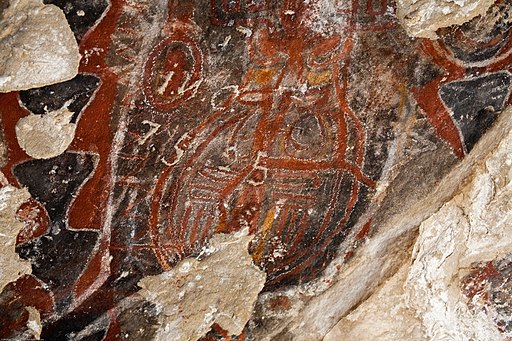The First People
Chumash History page on the Santa Ynez Band of Chumash Indians website.
Chumash People from Wikipedia, the free encyclopedia.
Native Americans of San Luis Obispo on the California Missions Resource Center website.
Map of Chumash Territory The Obispeño Chumash occupied the territory from the coast, inland to the Santa Lucia mountains in the east, Point Estero in the north, and to a shared boundary with the Purisimeño Chumash at approximately Pismo Beach in the south. They mostly occupied the coastal areas in the winter. In late spring they migrated inland, following seasonal migration routes along Chorro and San Luis Obispo Creeks.
The Chumash by Brian Fagan, from his book Time Detectives.
The Chumash Indian Council of San Luis Obispo County One of the primary goals of the SLO Chumash Council is to help local, state, and federal governments in their efforts to preserve historical sites for the study and appreciation of future generations. The page gives describes sites of historical and archaeological interest near San Simeon, Cambria, Avila Beach, Pismo Beach and Nipomo, among others, and links to other Chumash information.
The History of Avila Beach and Port San Luis Teacher Resource and Information. A collaborative work between the Port San Luis Harbor District and the San Luis Obispo County History Center.
THE GREAT NATURAL TEMPLE OF CARRISA
In the eastern portion of the county is the great Carrisa Plain, and on the rocks bordering it the most important of these paintings appear. On both the easterly and westerly sides of the plain the mountains are composed of a light-colored sandstone,  generally looking as if ready to wash away as a sand bank, but it evidently does not disintegrate so readily. In many places on the rocks have been painted strange characters and figures, evidently with careful design, resembling the hyeroglyphs of Egypt or the picture writings found in Mexico and Yucatan. Three colors have been generally used, red, black, and white. In various places on both sides of the plain have these singular and mysterious paintings been found, and the “oldest inhabitant” says that when the Spanish missionaries came a hundred years ago they found them as they now are, and wondered at their origin and meaning.
generally looking as if ready to wash away as a sand bank, but it evidently does not disintegrate so readily. In many places on the rocks have been painted strange characters and figures, evidently with careful design, resembling the hyeroglyphs of Egypt or the picture writings found in Mexico and Yucatan. Three colors have been generally used, red, black, and white. In various places on both sides of the plain have these singular and mysterious paintings been found, and the “oldest inhabitant” says that when the Spanish missionaries came a hundred years ago they found them as they now are, and wondered at their origin and meaning.
All this eastern section of the county, embracing an area of about half a million acres, is comparatively unoccupied, being mostly held in large tracts of from 20,000 to 60,000 acres by single individuals, and reserved for speculation or devoted to grazing. In the southwestern part of the Carrisa Plain Mr. Chester R. Brumley  and family settled in 1865, having as a nearest neighbor the cattle rancho at La Pariza, twenty-five miles distant north. west. In this wilderness, about three miles south of Mr. Brumley’s residence, stands in the open plain an exceedingly singular rock, made more interesting from the paintings of which it constitutes a grand and unique gallery. This bears the name of “The Painted Rock,” and is a most wonderful curiosity. From outward appearance the rock is a cone of about 750 feet diameter at the base, and 150 feet in height. On the east is an opening about 20 feet wide leading into a great room 225 feet in length by 120 feet in width at the widest place, the interior space being shaped like an egg, the point at the entrance. The walls are irregular, in places slightly overhanging, and in others slightly receding from the perpendicular, the highest point being about 132 feet above the inner base.* [*As measured by a spool of thread by Mrs. Brumley and her daughter, Miss Helen Brumley, who take great interest in this wonderful natural temple.]
and family settled in 1865, having as a nearest neighbor the cattle rancho at La Pariza, twenty-five miles distant north. west. In this wilderness, about three miles south of Mr. Brumley’s residence, stands in the open plain an exceedingly singular rock, made more interesting from the paintings of which it constitutes a grand and unique gallery. This bears the name of “The Painted Rock,” and is a most wonderful curiosity. From outward appearance the rock is a cone of about 750 feet diameter at the base, and 150 feet in height. On the east is an opening about 20 feet wide leading into a great room 225 feet in length by 120 feet in width at the widest place, the interior space being shaped like an egg, the point at the entrance. The walls are irregular, in places slightly overhanging, and in others slightly receding from the perpendicular, the highest point being about 132 feet above the inner base.* [*As measured by a spool of thread by Mrs. Brumley and her daughter, Miss Helen Brumley, who take great interest in this wonderful natural temple.]
The appearance is that of the crater of a volcano with one side broken away, but the rock is coarse sandstone. On the inner surface near the base, and at heights not exceeding twelve feet, are great numbers of paintings such as before described. Generally they are well preserved and the colors bright and distinct; but where most exposed to the rain, winds, and animals, they have become somewhat dimmed, but on the whole show a remarkable preservation. This, to the ancient pagan having a glimmering idea of religious belief, would be a grand and awe-inspiring temple made without hands, and even to the highest civilization must ever be regarded as a most interesting object. At present it is used as a corral, holding 4,000 sheep, closed by a short wall and set of bars at the entrance.
Source: History of San Luis Obispo County, California, by Myron Angel, Thompson & West, Oakland, California, 1883, p22. Transcribed for the CAGenWeb Project by Cathy Portz.

